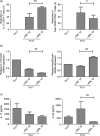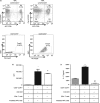The effect of mammalian target of rapamycin inhibition on T helper type 17 and regulatory T cell differentiation in vitro and in vivo in kidney transplant recipients
- PMID: 24974886
- PMCID: PMC4264911
- DOI: 10.1111/imm.12351
The effect of mammalian target of rapamycin inhibition on T helper type 17 and regulatory T cell differentiation in vitro and in vivo in kidney transplant recipients
Abstract
Sirolimus (SRL) is a promising alternative to calcineurin inhibitors, such as tacrolimus (TAC), in kidney transplant recipients (KTRs), but the immunological benefits of conversion from calcineurin inhibitors to SRL are not fully investigated. In the present study, we evaluated the effect of conversion from TAC to SRL on the T helper type 17/regulatory T (Th17/Treg) axis in three separate studies. First, the effect of SRL on the Th17/Treg axis was evaluated in vitro using peripheral blood mononuclear cells (PBMCs). Second, the effect of conversion from TAC to SRL on the Th17/Treg axis was studied in KTRs. Finally, the effect of SRL on CD8(+) Treg cells was evaluated. In vitro analysis of PBMCs isolated from KTRs showed that SRL suppressed Th17 cell differentiation but TAC did not. Conversion from TAC to SRL markedly decreased the number of effector memory CD8(+) T cells and significantly increased the proportion of CD4(+) and CD8(+) Treg cells compared with TAC in KTRs. SRL treatment induced the CD8(+) Treg cells, and these cells inhibited the proliferation of allogeneic CD4(+) T cells and Th17 cells. In conclusion, conversion from TAC to SRL favourably regulates Th17 and Treg cell differentiation in KTRs. These findings provide a rationale for conversion from TAC to SRL in KTRs.
Keywords: T cells; cytokines; mTOR; regulatory T cells; transplantation.
© 2014 John Wiley & Sons Ltd.
Figures






Similar articles
-
Differential Effects of Calcineurin and Mammalian Target of Rapamycin Inhibitors on Alloreactive Th1, Th17, and Regulatory T Cells.Transplantation. 2015 Sep;99(9):1774-84. doi: 10.1097/TP.0000000000000717. Transplantation. 2015. PMID: 25905982
-
Differential regulation of Tregs and Th17/Th1 cells by a sirolimus-based regimen might be dependent on STAT-signaling in renal transplant recipients.Int Immunopharmacol. 2015 Sep;28(1):435-43. doi: 10.1016/j.intimp.2015.07.006. Epub 2015 Jul 15. Int Immunopharmacol. 2015. PMID: 26186486 Clinical Trial.
-
Focus on mTOR inhibitors and tacrolimus in renal transplantation: pharmacokinetics, exposure-response relationships, and clinical outcomes.Transpl Immunol. 2014 Jun;31(1):22-32. doi: 10.1016/j.trim.2014.05.002. Epub 2014 May 24. Transpl Immunol. 2014. PMID: 24861504 Review.
-
Time-Dependent and Immunosuppressive Drug-Associated Adverse Event Profiles in De Novo Kidney Transplant Recipients Converted from Tacrolimus to Sirolimus Regimens.Pharmacotherapy. 2016 Feb;36(2):152-65. doi: 10.1002/phar.1692. Epub 2016 Jan 22. Pharmacotherapy. 2016. PMID: 26799522 Clinical Trial.
-
mTOR Signaling pathway as a master regulator of memory CD8+ T-cells, Th17, and NK cells development and their functional properties.J Cell Physiol. 2019 Aug;234(8):12353-12368. doi: 10.1002/jcp.28042. Epub 2019 Feb 2. J Cell Physiol. 2019. PMID: 30710341 Review.
Cited by
-
Pretransplant, Th17 dominant alloreactivity in highly sensitized kidney transplant candidates.Front Transplant. 2024 Apr 8;3:1336563. doi: 10.3389/frtra.2024.1336563. eCollection 2024. Front Transplant. 2024. PMID: 38993777 Free PMC article.
-
Clinical significance of Th17 cells in kidney transplantation.Korean J Intern Med. 2018 Sep;33(5):860-866. doi: 10.3904/kjim.2018.095. Epub 2018 May 31. Korean J Intern Med. 2018. PMID: 29843491 Free PMC article. Review.
-
Dissecting the Multiplicity of Immune Effects of Immunosuppressive Drugs to Better Predict the Risk of de novo Malignancies in Solid Organ Transplant Patients.Front Oncol. 2019 Mar 27;9:160. doi: 10.3389/fonc.2019.00160. eCollection 2019. Front Oncol. 2019. PMID: 30972289 Free PMC article. Review.
-
A Phase I Clinical Trial with Ex Vivo Expanded Recipient Regulatory T cells in Living Donor Kidney Transplants.Sci Rep. 2018 May 9;8(1):7428. doi: 10.1038/s41598-018-25574-7. Sci Rep. 2018. PMID: 29743501 Free PMC article. Clinical Trial.
-
Pharmacologic targeting of regulatory T cells for solid organ transplantation: current and future prospects.Drugs. 2015 Nov;75(16):1843-52. doi: 10.1007/s40265-015-0487-6. Drugs. 2015. PMID: 26493288 Review.
References
-
- Halloran PF. Immunosuppressive drugs for kidney transplantation. N Engl J Med. 2004;351:2715–29. - PubMed
-
- Hariharan S, Johnson CP, Bresnahan BA, Taranto SE, McIntosh MJ, Stablein D. Improved graft survival after renal transplantation in the United States, 1988 to 1996. N Engl J Med. 2000;342:605–12. - PubMed
-
- Vincenti F, Friman S, Scheuermann E, et al. Results of an international, randomized trial comparing glucose metabolism disorders and outcome with cyclosporine versus tacrolimus. Am J Transplant. 2007;7:1506–14. - PubMed
-
- Li C, Yang CW. The pathogenesis and treatment of chronic allograft nephropathy. Nat Rev Nephrol. 2009;5:513–9. - PubMed
-
- Kasiske BL, Snyder JJ, Gilbertson DT, Wang C. Cancer after kidney transplantation in the United States. Am J Transplant. 2004;4:905–13. - PubMed
Publication types
MeSH terms
Substances
LinkOut - more resources
Full Text Sources
Other Literature Sources
Medical
Research Materials
Miscellaneous

